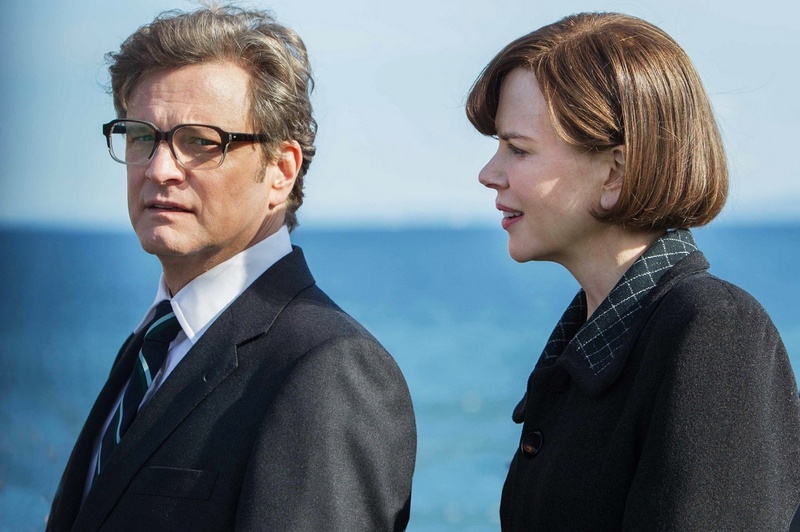“I’m a railway enthusiast,” the young Eric Lomax (Jeremy Irvine) says. In most stories, the comment might be taken lightly. But “The Railway Man” is not a typical story. Instead, it is the true story of the struggles of a man in love with railways as he is captured by the Japanese and forced to help build the Burma Railway during World War II. It is the tale of his suffering from psychological trauma years later and it is an account of his attempts to find solace after locating the Japanese man behind his pain. As the film moves forward, the track taken is one both formidable and moving.
{shortcode-156ffe90c1b2b2a9e9f5ee5820ea065692476bd6}
When the film begins, an older Lomax (Colin Firth) lying on the floor recites in a subdued, dead voice, “At the beginning of time, the clock struck one.” The camera trails from his feet to his face, a ghastly image when framed with the darkness and stream of light hitting his body. The introduction sets a reflective and philosophical tone, a tone carried throughout the film as Lomax tries to battle his inner demons from his war years.
Scene after scene, director Jonathan Teplitzky employs deft cinematography, integrating thoughtful visuals with a fitting soundtrack. The score reflects each moment’s mood, adding light to the romantic moments and darkness to any mention of the war. As Lomax’s wife, Patti (Nicole Kidman), researches his past and looks into images of the war in his notebooks, a steady drumbeat drives the tense moments forward until the low percussion becomes a high-pitched buzz, paralleling the sketches’ downward spiral from images of capture to those of torture. Visually, Teplitzky barrages the audience with a mix of muted and vibrant colors; in 1980s England, hues of grey, blue, and brown make up the color palate, a surprising contrast to the bright greens of 1930s World War II-era Thailand. Memory is more vivid than reality, a scenic suggestion that for the characters, the past overshadows the present.
But a beautiful backdrop is nothing without suitable actors, and “The Railway Man” delivers in that regard. Firth, acclaimed for his roles as a depressed university professor in “A Single Man” and King George VI in “The King’s Speech,” proves once again his ability to portray with a masterful realism characters afflicted by complicated conflicts. As the older Lomax, Firth must deftly show a man near breaking point, too caught in internal suffering, trying to maintain a complacent façade—something he accomplishes through careful changes in his face, large enough to be discerned but small enough to avoid seeming like caricatures. Firth’s control over his facial expressions is strong and communicative, and the camera’s regular pan onto his face allows the audience to slowly understand Lomax’s grief.
The most poignant performance, however, is Irvine’s as Firth’s younger counterpart. While Firth’s acting captures subtleties, Irvine is more explosive—fitting as the torture occurs in the present for him. During the most painful parts of Lomax’s time as a prisoner of war, Irvine’s dilated eyes capture all attention, a blankness within them that seems to suggest Lomax’s weakening resolve. These minute details grant Lomax’s depiction emotional weight, and the acting becomes another testament to how the film foregoes flash for something more innately human.
The only glaring issue with “The Railway Man” is its treatment of the story. While a majority of the film transitions fluidly between key scenes and different time periods, certain turns in the script feel sharp. Lomax’s romance with Patti at the beginning is meant to be sweet: “I’ve never kissed a man with a mustache before, and I won’t do it again,” Patti says to the then-mustachioed Lomax, and while the remark might sound contrived done wrong, Kidman delivers it so earnestly that it is more charming than laughable. Yet following the haunting, macabre first scene, these warm exchanges instead leave one cold. Such discordances disorient the viewer and detract from the film’s tone until even a striking, memorable denouement seems jarringly foreign against the rest of the film’s development.
Any peculiar moments, however, are redeemed by the film’s stunningly nuanced execution. It is raw acting and thoughtful visuals that propel the story to a resolution of heartbreak and enlightenment, that make a predictable ending still powerful, and that ultimately transform “The Railway Man” into an epic adaptation of a true story.
—Contributing writer Ha D.H. Le can be reached at hadohuyle@college.harvard.edu.
Read more in Arts
Georgia "In Bloom"













